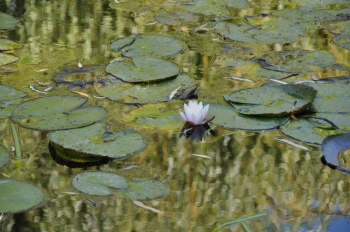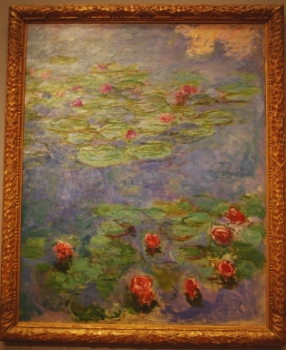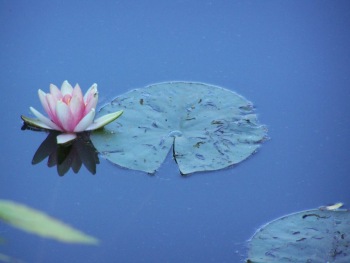May 18, 2015
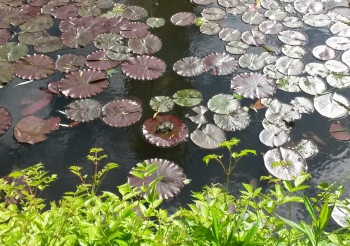
Claude Monet’s water lily pond in May, when frogs croak and sit on pads…
The first Nympheas have opened! They will flower until September.
I’m grateful to the kind visitor that quoted the above title, and then patiently explained to me the related colloquialism and thus the joke. In French we don’t have the same image. We say that time passes in a lightning, le temps passe en un éclair. The way each language expresses reality and experiences its own way is an endless source of amazement and amusement to me.
Posted in Water-Garden No Comments »
May 20, 2012
This is Monet’s pond at Giverny seen from the Japanese Bridge in May, when the wisterias are in bloom.
The water lily pads float like islands on the surface. No flowers yet.
Short before closing time, visitors are few. The late afternoon sunshine enlightens the trees on the eastern side of the pool. Silence falls on the garden. The scent of the flowers is in the air.
Posted in Giverny, Water-Garden No Comments »
October 11, 2011
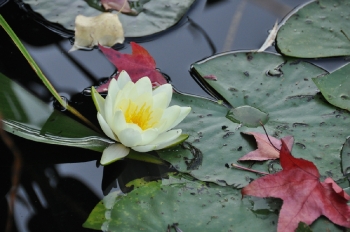 Autumn leaves fall on Claude Monet’s pond at Giverny, creating new beauties, new color harmonies.
Autumn leaves fall on Claude Monet’s pond at Giverny, creating new beauties, new color harmonies.
Posted in Water-Garden 1 Comment »
July 3, 2011
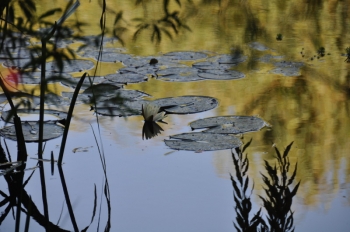 Water lilies are sensitive to cold. When the night is overcast and mild, they are all open in the morning. But if the night is clear, they close and need several hours of sunshine to open again.
Water lilies are sensitive to cold. When the night is overcast and mild, they are all open in the morning. But if the night is clear, they close and need several hours of sunshine to open again.
They like a warm water not only to open, but also to bloom. On Monet’s pond, water lilies are gorgeous during heat waves, they become scarce during rainy and cool periods.
This is true for a big pond like Giverny. For gardeners who would like to grow water lilies in a wash basin, it is wise to look for a partly shaded spot. In direct sunshine, the water of a small container becomes very warm. If some like it hot, it is not the case of water lilies.
Posted in Giverny, Water-Garden, Flower No Comments »
August 1, 2010
Water lilies are summer flowers.
They like a warm water and a lot of sunshine.
In Monet’s garden at Giverny, the Nympheas that grace the pond are at their peak.
Their crowns of pale petals reflect in the changing colors of the surface, creating harmonies that inspire the many painters visiting the gardens.
Posted in Water-Garden, Flower No Comments »
February 22, 2010
The Palace of the Legion of Honor in San Francisco surprises French visitors by the words written on the pediment of the main entrance : Honneur et Patrie. Surprises continue with its beautiful collection of European art including five gorgeous Monets.
The biggest one faces visitors at the end of a perspective through several large rooms. It deserves this honor. This enormous canvas of Monet’s late period, painted during World War One, is certainly one of the most splendid masterpieces of the museum.
Monet focuses on two patches of water lilies floating on the pond in his garden at Giverny. Unlike many of the paintings in this series, this canvas is very bright. Vibrant reds and pinks pop out the flowers, contrasting with the soft greens of the lily pads and the pale blue of the reflected sky. Curiously enough, a cotton like cloud occupies the upper corner of the painting, when it should be reflected at the lower part of the canvas. It is one of Monet’s favorite game to mix all the landmarks to create confusion in the eyes of the viewer.
Posted in Monet Painting No Comments »
December 7, 2008
The colors tend to disappear under the soft veil of the fog.
Mist likes to stick in the Seine valley, especially on chilly autumn and winter’s days. This magician creates strange effects, unreal silvery lights that linger over Claude Monet’s pond at Giverny.
The usually precise lines of the reflections on the surface become less defined.
Like a parenthesis of hapiness on a dull day, the pink nympheas prove that colors are not swollen by the grey shades as they are by the night, but only softened. A careful look reveals them. The surrounding greys make them even more vivid.
Posted in Giverny, Water-Garden 1 Comment »
September 11, 2008
Claude Monet made his garden famous by painting it over and over again. There are 272 canvases by Monet featuring his water garden, not to speak about the Grandes Decorations, these oversized panels that can be seen at l’Orangerie Museum in Paris.
Monet didn’t want any other motive for almost twenty years. He was in his seventies and eighties and didn’t feel like travelling for long painting campaigns anymore.
In addition there was war, the first World War from 1914 through 1918. Monet preferred to stay in his garden to paint. Here he found all the inspiration he needed.
Monet painted his pond or his bridge repeatedly, because for him there were never the same. What he wanted to render was not especially a flower or a bridge, but the light on them, the air that wraps them. And the light changes all the time.
Posted in Water-Garden, Monet Painting No Comments »
July 16, 2008
At Monet’s time, only white water lilies grew wild in France.
They were hardy flowers, able to stand cold and frost, whereas pink or yellow water lilies were of exotic origin and needed a warm greenhouse to spend the winter.
When Monet created his water garden at Giverny and imagined a pond with floating islands of colorful nympheas, these flowers where very modern.
By the end of the nineteen century a man called Bory Latour-Marliac had the idea of cross fertilizing hardy white water lilies with exotic ones. He was successful and obtained a full palette of hardy waterlilies. In 1889, the year of the Eiffel tower, Latour-Marliac exhibited his new creations at the Universal Exhibition in Paris, where Monet saw them. Four years before he had his pond dug he conceived the idea of it by seeing the beautiful water flowers.
Would Latour-Marliac not have created his flowers, Monet would probably not have painted his Nympheas masterpieces.
Posted in Water-Garden, Flower 1 Comment »




